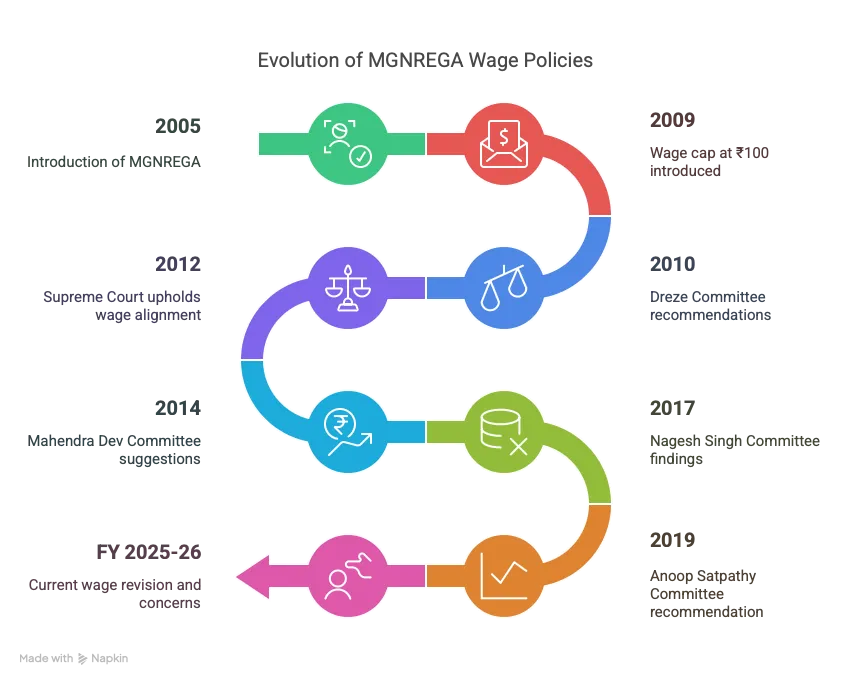UPSC
Indian Express Concise
MGNREGA Wage Revision: Ensuring Economic Security for Rural India
Last Updated
11th April, 2025
Date Published
11th April, 2025
Share This Post With Someone


- Program Overview: Mahatma Gandhi National Rural Employment Guarantee Act (MGNREGA) is the world’s largest employment guarantee program, with over 25 crore registered workers, providing up to 100 days of unskilled manual work annually to rural households.
- Objective: Aims to enhance livelihood security for rural poor by ensuring economic stability through guaranteed employment.
- Wage Notification: For FY 2025-26, the Ministry of Rural Development (MoRD) notified state-wise daily wage rates in late March, ranging from ₹241 (Nagaland) to ₹400 (Haryana), with a national average of ₹294, reflecting a 5% increase from FY 2024-25.
- Wage Concerns: Key issues include wages lagging behind inflation, falling below subsistence levels, and increasing divergence from state minimum wages, undermining the program’s goal of economic security.
- Parliamentary Committee Findings: A parliamentary panel noted that MGNREGA wages fail to keep pace with inflation, making it challenging for workers to sustain themselves, thus weakening the scheme’s effectiveness.
- Historical Wage Cap: In 2009, the Centre capped MGNREGA wages at ₹100, leading to real-term wage declines as it diverged from the Minimum Wages Act (MWA) standards.
- Judicial Interventions:
- Karnataka High Court (2011) ruled that MGNREGA wages must align with state minimum wages under MWA.
- Supreme Court (2012) upheld this, reinforcing that wages below minimum standards violate legal norms.
- Dreze Committee (2010): Led by economist Jean Dreze, it recommended aligning MGNREGA wages with state minimum wages under Section 6(2) of the Act and indexing wages to the Consumer Price Index for Agricultural Labourers (CPI-AL) to counter inflation.
- Mahendra Dev Committee (2014): Suggested MGNREGA wages should match or exceed state minimum wages and be indexed to Consumer Price Index-Rural (CPI-R), with a base year update from 2009 to 2014, but the Ministry of Finance rejected this citing fiscal burden.
- Nagesh Singh Committee (2017): Comprised only government representatives, it argued against linking MGNREGA wages to state minimum wages but proposed shifting from CPI-AL to CPI-R for indexing; MoRD retained CPI-AL in 2021 without explanation.
- Anoop Satpathy Committee (2019): Recommended a National Floor Wage of ₹375/day (July 2018 prices) as a benchmark for all sectors, including MGNREGA; only Goa and Haryana exceed this in FY 2025-26.
- Current Wage Gap: MGNREGA wages are lower than state minimum agricultural wages in nearly every state, with gaps exceeding ₹200 in some cases, violating MWA and Supreme Court directives.
- Stakeholder Advocacy: Worker unions, civil society, and parliamentary committees have consistently demanded higher wages for over a decade to align with minimum wage standards and inflation.
- Economic Implications: Low wages reduce the program’s ability to provide a safety net, impacting rural consumption and economic stability.
- Inflation Indexation Issue: Continued use of CPI-AL, based on outdated consumption patterns, results in inadequate wage revisions compared to CPI-R, which better reflects rural consumption.
Glossary:
- MGNREGA: A 2005 Act guaranteeing 100 days of unskilled wage employment to rural households to enhance livelihood security.
- Minimum Wages Act (MWA): A 1948 law mandating minimum wage rates for workers, set by states for various sectors.
- Consumer Price Index for Agricultural Labourers (CPI-AL): An index measuring price changes based on agricultural workers’ consumption patterns, used for MGNREGA wage revisions.
- Consumer Price Index-Rural (CPI-R): An index reflecting rural household consumption, proposed for more accurate MGNREGA wage adjustments.
- National Floor Wage: A recommended minimum wage benchmark to ensure uniformity across states and sectors.
Link To The Original Article – https://indianexpress.com/article/explained/explained-economics/why-nrega-wage-rates-should-be-revised-9937389/